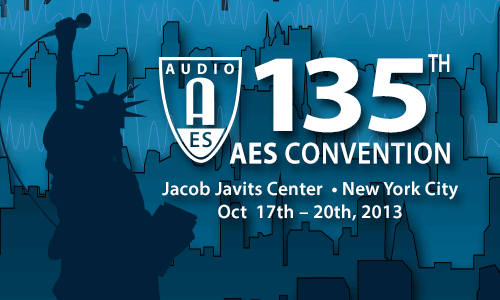AES New York 2013
Paper Session P8
P8 - Recording and Production
Friday, October 18, 9:00 am — 12:00 pm (Room 1E07)
Chair:
Richard King, McGill University - Montreal, Quebec, Canada; The Centre for Interdisciplinary Research in Music Media and Technology - Montreal, Quebec, Canada
P8-1 Music Consumption Behavior of Generation Y and the Reinvention of the Recording Industry—Barry Marshall, The New England Institute of Art - Brookline, MA, USA
This paper will give an overview of the last 15 years of the recording industry’s problems with piracy and decreasing sales, while reporting on research into the music consumption behavior of a group of audio students in both the United States and in eight European countries. Audio students have a unique perspective on the issues surrounding the recording industry’s problems since the advent of Napster and the later generations of illegal file sharing. Their insights into issues like the importance of access to music, the quality of the listening experience, and the ethical quandary of participating in copyright infringement, may help point to a direction for the future of the recording industry.
Convention Paper 8956 (Purchase now)
P8-2 (Re)releasing the Beatles—Brett Barry, Syracuse University - Syracuse, NY, USA
This paper presents a comparative analysis of various Beatles releases, including original 1960s vinyl, early compact discs, and present-day digital downloads through services like iTunes. I will provide original research using source material and interviews with persons directly involved in recording and releasing Beatles albums, examining variations in dynamic range, spectral distribution, psychoacoustics, and track anomalies. Considerations are given to mastering and remastering a catalog of classics.
Convention Paper 8957 (Purchase now)
P8-3 Maximum Averaged and Peak Levels of Vocal Sound Pressure—Braxton Boren, New York University - New York, NY, USA; Agnieszka Roginska, New York University - New York, NY, USA; Brian Gill, New York University - New York, NY, USA
This work describes research on the maximum sound pressure level achievable by the spoken and sung human voice. Trained actors and singers were measured for peak and averaged SPLs at an on-axis distance of 1 m at three different subjective dynamic levels and also for two different vocal techniques (“back” and “mask” voices). The “back” sung voice was found to achieve a consistently lower SPL than the “mask” voice at a corresponding dynamic level. Some singers were able to achieve high averaged levels with both spoken and sung voice, while others produced much higher levels singing than speaking. A few of the vocalists were able to produce averaged levels above 90 dBA<, the highest found in the existing literature.
Convention Paper 8958 (Purchase now)
P8-4 Listener Adaptation in the Control Room: The Effect of Varying Acoustics on Listener Familiarization—Richard King, McGill University - Montreal, Quebec, Canada; The Centre for Interdisciplinary Research in Music Media and Technology - Montreal, Quebec, Canada; Brett Leonard, McGill University - Montreal, Quebec, Canada; The Centre for Interdisciplinary Research in Music Media and Technology - Montreal, Quebec, Canada; Scott Levine, Skywalker Sound - San Francisco, CA, USA; The Centre for Interdisciplinary Research in Music Media and Technology - Montreal, Quebec, Canada; Grzegorz Sikora, Bang & Olufsen Deutschland GmbH - Pullach, Germany
The area of auditory adaptation is of central importance to a recording engineer operating in unfamiliar or less-than-ideal acoustic conditions. This study prompts expert listeners to perform a controlled level-balancing task while exposed to three different acoustic conditions. The length of exposure is varied to test the role of adaptation on such a task. Results show that there is a significant difference in the variance of participants’ results when exposed to one condition for a longer period of time. In particular, subjects seem to most easily adapt to reflective acoustic conditions.
Convention Paper 8959 (Purchase now)
P8-5 Spectral Characteristics of Popular Commercial Recordings 1950-2010—Pedro Duarte Pestana, Catholic University of Oporto - CITAR - Oporto, Portugal; Lusíada Universityof Portugal (ILID); Centro de Estatística e Aplicacoes; Zheng Ma, Queen Mary University of London - London, UK; Joshua D. Reiss, Queen Mary University of London - London, UK; Alvaro Barbosa, Catholic University of Oporto - CITAR - Oporto, Portugal; Dawn A. A. Black, Queen Mary University of London - London, UK
In this work the long-term spectral contours of a large dataset of popular commercial recordings were analyzed. The aim was to analyze overall trends, as well as yearly and genre-specific ones. A novel method for averaging spectral distributions is proposed that yields results that are prone to comparison. With it, we found out that there is a consistent leaning toward a target equalization curve that stems from practices in the music industry but also to some extent mimics natural, acoustic spectra of ensembles.
Convention Paper 8960 (Purchase now)
P8-6 A Knowledge-Engineered Autonomous Mixing System—Brecht De Man, Queen Mary University of London - London, UK; Joshua D. Reiss, Queen Mary University of London - London, UK
In this paper a knowledge-engineered mixing engine is introduced that uses semantic mixing rules and bases mixing decisions on instrument tags as well as elementary, low-level signal features. Mixing rules are derived from practical mixing engineering textbooks. The performance of the system is compared to existing automatic mixing tools as well as human engineers by means of a listening test, and future directions are established.
Convention Paper 8961 (Purchase now)
